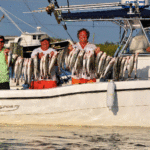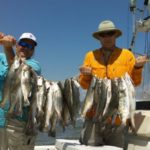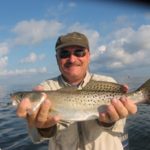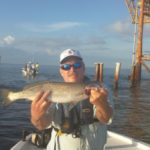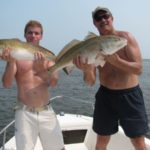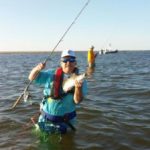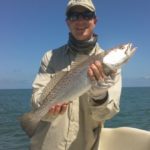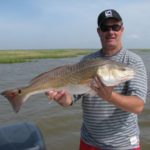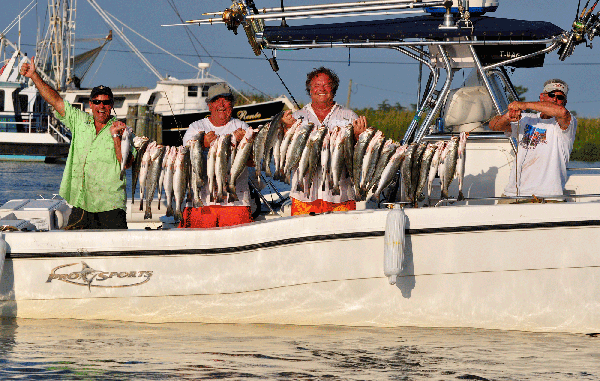
Whether you fish the marshes at the mouth of the Mississippi River or head out to Breton Sound, Venice is the best jumping-off point in the world.
Pelayo eased back on the throttle, and we idled toward shore at (what’s left) of Grand Gosier Island. We gaped at water that looked more like Destin’s Crab Island or the Florida Keys than anything usually within reach of a Louisiana marina.
Legendary Breton Sound “speck-chaser” Johnny Morise and his crew had beat us out this morning. Morise was waist deep in the emerald water, cranking his reel and twitching his topwater Badonk-a-Donk.
He stopped, looked over and waved frantically.
“Man!” he yelled. “This waaaw-daw sure don’t look like when we’re wade fishing outta Grand or Elmer’s island!”
“Heck no!” answered Eddie, who stood on the bow and pointed a bit ahead of Johnny. “Out there you can’t see the sharks nearly as well!”
“Or the stingrays!” added Chris, pointing behind him.
Johnny stopped waving, and we all scurried to the bow next to Eddie.
“Nice one!” yelled Chris. “Maybe a 4-footer!”
Johnny cranked in his lure and stood motionless, trying to look cool.
“Saw one earlier” he stuttered. “Came right up to me. Plenty of them out here today. But I’d rather have them around than stingrays. Ain’t seen too many rays out this morning.”
Johnny kept his cool and cast out again.
“Its part of fishing out here,” he shrugged. “Get used to it.”
Four cranks into his retrieve …
“Hah!” he yelled.
We all saw the blow-up, and he yelled as his pole arched and the water in front of him erupted in swirls.
“Sharks are around here for the same reason we are!” Johnny whooped. “They’re after da specks!”
In minutes, the four of us were wading in the warm, emerald water and all casting toward “da trench,” as Johnny had advised the previous — and festive — night. Two of us threw silver Badonk-a-Donks; two tossed silver-flake Deadly Dudleys.
Chris hooked up first.
“Deyz here!” he yelled.
“Better tighten your drag,” Pelayo counseled. “But dat don’t sound like no spec anyway. Fighting too hard. “Probably a Spanish mackerel. Tough-fighting, great-eating and no parasites — so naturally he’s a trash-fish in Louisiana.
“Now don’t trow him back — here!”
And Pelayo waded over and grabbed the fish, just as a disgusted Chris ripped the hook out and prepared to chunk the frantically shaking Spanish to the sharks.
Pelayo grabbed it and strung it up on his stringer.
“We’ll broil the fillets in lemon butter tonight,” he smirked. “Just maybe you’ll leave me some — watch!”
Fourteen old Tigerland college chums converged at Doc’s Venice houseboat for three days of serious fishing, serious revelry and serious reminiscing. On top of the luxuries, it would be difficult to imagine a more centrally located fishing headquarters than Doc’s houseboat. ESPN, after all, rated Venice “the top fishing port in America.”
We can argue about that till the cows come home. But there’s no denying the options down here. Out of Venice with 20-foot-plus boats the options are mind-boggling. Out to Breton and Gosier islands and Breton Sound for specks? To the Canyon or Lump for tuna and wahoo? To Blind and Redfish bays for specks and reds? To the spillways for reds? Out through Red Pass to the shallow West Deltas for pompano, Spanish and mangroves? To the rosseau coastline from Grand Pass around to Red Pass for redfish action?
How ’bout the rocks at South or Southwest passes? If you can’t catch bull-reds there — hang it up!
The options — all delicious to contemplate — can drive a fanatical fisherman dizzy. No fishing locale in America offers such diversity. Not even close.
The Rolling Stones were cranked up loudly the night before, and we were seriously pumped and boisterous while contemplating the coming morning’s options. But we noticed that the racket on a nearby houseboat was outdoing ours!
We looked over from the railing and saw people waving at us while dancing crazily. Most looked female. Then we noticed the two who’d been waving scurry around their railing.
In seconds, they’d stomped up Doc’s stairs.
“Come on, guys!” they shrieked. “Party’s just starting!”
We didn’t require much prodding. Once on their deck, it only took seconds to note that the gals were taking full advantage of the gloriously windy weather, all decked out in hip-riding short-shorts, skimpy tops and flip-flops. Most were dancing. All were pink-cheeked and giggly, holding drinks.
I was trying to get a handle on the scene when I felt my arm jerked.
“Let’s go, big guy!” yelled a curvaceous brunette in hoop earings and a skimpy tank top that terminated well north of her navel. “Time to shake a leg!”
Thelma Houston’s “Don’t Leave Me This Way” suddenly boomed from the speakers. The gal whooped, lifted her arms overhead and started strutting her stuff.
Nobody talked much as we boarded the boats the next morning, even though it was 8 a.m. All was quiet as our armada of three boats cruised down Baptiste Collette, Breton Sound-ward as dictated by the westerly winds. The western shoreline from Sandy Point Bay down to Bay Zin-Zin would all be chocolate milk, experience told us.
The chatter on the radio was low-key and perfunctory.
One of our fleet turned around midway to Breton Island.
“Too choppy,” Maxwell said on his radio.
They turned around and aimed for the rosseau cane coastline around Tessiers Bend and the mouth of Main Pass, which was sheltered from the southwest wind and seemed likely to produce hot redfish action. While bogeying with us to the Stones at Doc’s, legendary Venice fishing guide Kyle Maher had filled us in on the prospects along that eastern coastline.
“Find some (fairly) clear, moving water in 2-foot depths close to the canes with some mullet or shiners swimming around,” Maher advised.
This applies from around the mouth of Romere Pass all the way around and down to Customhouse Bay. Same basic pattern.
“Cast with dead shrimp under a popping cork,” Maher said. “You’ll find some reds. With probably a few puppy drum and flounder mixed in.”
And Maher should know.
First stop was (what’s left of) Breton Island. A half hour of dunking Carolina-rigged live shrimp along the lee side yielded two gafftops.
After an hour, Johnny and crew had left for Gosier. An hour later, they radioed that they had yet to drown a croaker or shrimp. Instead they were wade fishing with plastics and …
“Wailing on them!”
Off we roared. And soon eight of us were spread out, wading and casting along the southeast tip of Gosier Island — site of the famous (for Johnny) speck locale known as “Da Trench.”
Trout can be found just about anywhere along either side of this barrier island. But it’s a nice little haul out here by boat (different by floatplane), so to economize on time we try to zero in on the most-likely speck havens.
Johnny Morise fishes out here year round. He’s come to the conclusion that the ledge along the southeast tip of the island, where the water drops off to 12 feet or so from the normal 3-foot depths of most of the coastline, tends to hold the specs.
There’s usually a good current here. Spot some mullet schooling in the area and it’s a pretty sure bet.
And sure enough: The mullet were around. It figures. Ledges seem to do this for fishing everywhere—fresh or salt water, inshore or offshore.
My third cast with a Saltwater Assassin drove the point home. In seconds the spec burst on the surface, and I whooped in celebration — just as Pelayo joined in from 20 feet away. He’d also cast to the edge of “Da Ledge.”
Man, there’s just something about wade-fishing (despite the sharks and stingrays.) Beating the heat is obviously one of the advantages. But for us who cut our teeth wade fishing Lake Pontchartrain along the Metairie and Kenner shorelines from the causeway to Williams — for us, it really put an extra-big smile on our faces.
Here we were, essentially the same crew of hoodlums who’d tie our stringers of trout (caught on shad rigs, Sidewinders and specs a go-go) on the banana handlebars of our Stingrays and peddle home to clean the catch and have our moms fry them up.
Then we’d watch Morgus the Magnificent during a grammar-school sleepover.
Here we were, still at it 40 years later — in a slightly different setting, and with slightly different waistlines and hairlines.
Wading around Gosier, we caught about a dozen trout each — plenty enough action by our standards. The trout averaged from 2 to 4 pounds — not monsters. But plenty big enough for us.
After two hours or so, the action finally petered out, and we moved on to the famous “rig” known as “The Holy Cross” — long a favorite for Breton Sound trout aficionados.
We idled around it, looking for an opening. Already a few boats had converged and anchored around it.
“Guy over there is netting another one!” Eddie gasped from the bow, while pointing at a twin-V anchored on the very corner of the rig.
He was the only one who we’d seen catch anything. Now he was netting his third trout in the few minutes.
Here was a classic Breton Sound trout situation. You see it from The Wreck, through Battledore, Da Central and here at the Holy Cross — somebody mopping up on one little corner of the structure; nobody else catching jack.
One explanation may be current flow. From scuba-diving, we know that most fish tend to congregate on the upcurrent side of a rig. LSU’s wetland center did a study dropping some kind of a sonar contraption around rigs and confirmed it.
A trolling motor helps ameliorate this problem — at least it did for us because the current would have bashed us into the rig if we’d used the traditional rig hook. We managed to hover around the hot corner of the rig without provoking a flare gun shoot-out with the boats in the area, although it came close at times.
Chris was the first to cast, using a live shrimp on a sliding cork set for 15 feet. In half a minute, the cork plunged.
I looked up, and his medium spinning rod was bowed over beautifully. Then it started jerking from brutal lunges characteristic of big specks. Then a big trout exploded on the surface in a gorgeous froth as Pelayo whooped from the bow with another.
“Somebody better get the net!” Chris’ face was creased in a gargantuan smile.
Soon I netted his speck: about a 3-pounder.
Now Pelayo was whooping from the stern as a big trout whipsawed his ultra-light rod. I finally hooked a live shrimp through the horn and nailed a nice speck not 15 seconds after it hit the water about 20 feet from the rig’s corner.
Then I got three snags trying Carolina rigs. The bottom around this rig seems heavily littered with snags, probably from all the recent hurricanes.
I finally relented and went over to the sliding cork after my three chums had been battling speck after speck that had been plunging theirs.
After a while, I noticed the specks caught on croakers averaged slightly bigger than those caught on live shrimp. All of the 26 we boated ranged from 2 to 5 pounds. Three were over 5, which freaked us out.
We caught trout steadily for an hour and a half — for exactly as long as the live shrimp and croakers lasted.
Then we caught a few puppy drum, sheepshead and two nice borderline bull reds on dead shrimp — but nary a speck. Not one speck. Not one on artificials, either.
By employing the trolling motor, we were able locate their hotspots around structures much more easily than by hooking and unhooking, anchoring and lifting anchor. In brief, outer Breton Sound lived up to its reputation as a summer spec hotspot — and for two days in a row.
The following morning we opted for reds, but again along the eastern shoreline, concentrating on area between Tessiers Bend and Buras Bayou in the pocket of water between Baptiste Collette and Main Pass.
We were blazing along when Pelayo grabbed my shoulder.
“Look at the prop wash,” he signaled with a nod.
The foam was almost white. We slowed down and idled towards the canes. “This waaaw-da has redfish written all over it,” Eddie beamed, as he eased down the trolling motor.
For successful redfishing, we always look for what area fishing guide Kyle Maher has taught us as the “Holy Trinity:” 1) clear water, 2) depths of 2 to 3 feet close to the shore and 3) moving water.
Here we found them all, as Pelayo cast to a cut in the rosseaus with water moving out. Many such cuts mark this area.
I also cast out near the cut’s mouth with a nice hunk of shrimp on a chartreuse beetle 2 feet under a popping cork, and watched it bob in the current.
I reached for a drink. Looked up: Where’s my cork?
I frantically reeled in the slack, and — “Whoa!”
The battle was joined. The reel sang its sweet music as the brute aimed for Main Pass. Then the fish hit the surface about 50 yards out with a breathtaking eruption of froth and copper.
The red aimed back for the canes with a spirited run. Then back north.
“Another one! Here!” Pelayo grunted, setting the hook with the “here.” “Another monster!”
It exploded on the surface and made for Breton Island.
Two reels singing, and Chris had yet to cast. In seconds, his shrimp-tipped beetle sailed out toward the edge of the canes.
Four pops after that and his battle was joined.
Two hours of working about a quarter of a mile of cane-studded coastline and we had 11 reds from 3 to 9 pounds in the box.
Nothing close to limits, but plenty enough action and eating for all of us.
The fishing was hot, the weather hotter, and the camaraderie and horseplay the hottest of all. The weekend zoomed by much too quickly for all of us.
